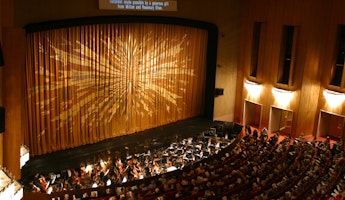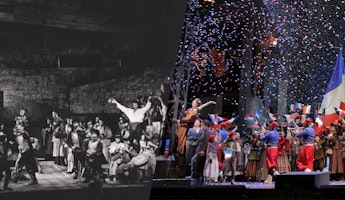Blog
March 8, 2024
Our History with the Oscars
Los Angeles is an exciting city to be in, perhaps never more so than during Oscar season. The movie capital of the world seems to get that much more lively and the discourse much more engaging when it’s time to recognize the best movies of the year. While we are just as swept up in awards season as anyone else, we also can’t help but feel nostalgic for a time when the award ceremony would take place in our home theater. For those who don’t know, the Oscars were held at the Dorothy Chandler Pavilion for nearly three decades starting in 1969, though they shifted locations multiple times in the mid-80s to 90s. This happened thanks to Dorothy Chandler herself, a powerhouse who not only raised most of the money to construct the building, but also convinced the Academy to hold the Oscars there. The Academy had some hesitation, but in the end couldn’t resist the magnificent and beautiful design of the then-new Pavilion. Let’s look at some of the most iconic and fascinating moments that happened while the Oscars took place in our home.
The first Oscar ceremony in the DCP had some notable winners:
- The musical Oliver! became the first and only G-rated movie to win Best Picture
- Stanley Kubrick won the Oscar for Best Visual Effect for 2001: A Space Odyssey, his first and only Oscar
- While we’re talking about first and onlys, that was also the year that saw the first and only tie for Best Actress between Katharine Hepburn for The Lion in Winter and Barbra Streisand for Funny Girl.
Overall, the ceremony was a fun introduction for the Oscars at the DCP and had some historic feats for some of the greatest cinematic legends.
In subsequent ceremonies at the DCP, Midnight Cowboy became the first and only X-rated movie to win Best Picture (1970) and George C. Scott refused his Oscar win for Patton in 1971 because he didn’t believe that actors should be in competition with each other. The 1972 Oscars saw one of the last public appearances of actress Betty Grable, who would pass away from lung cancer a year later and was also the first ceremony that had the nominees' pictures superimposed while they were announced.
Perhaps the most notable moment of the 1972 ceremony occurred when Hollywood legend Charlie Chaplin was given an Honorary Academy Award. Since Chaplin had been an icon of Hollywood's silent era, the bulk of his movies had been made before the Oscars existed. Blacklisted during the Red Scare because of his progressive views, Chaplin moved to Switzerland and severed all ties with Hollywood, remaining a controversial figure in the industry for decades. His Honorary Oscar was an attempt by the Academy to make amends. It had been 20 years since Chaplin had set foot in the U.S. and he was hesitant to come back. But when he walked onto the stage to receive his Oscar, he received a 12-minute standing ovation, the longest in Oscar history and perhaps the longest ever in DCP history.
It wasn’t the last time Hollywood needed to right a wrong. The 1973 Oscars were the most viewed in its history. With groundbreaking hits like The Godfather and Cabaret nominated for multiple awards, it was sure to be a night to remember no matter the outcome. The biggest stars of the time were there, of course, but what is remembered most about that night is who wasn’t there. Marlon Brando was leading the race to win Best Actor over Michael Cain, Laurence Olivier and Peter O’Toole, but the method actor didn’t have any plans to attend the ceremony. Instead, he asked Sacheen Littlefeather, an actress and activist for Native American rights, to decline the award in his stead and to bring up the mistreatment of Native Americans in film. Her speech was met with boos and Littlefeather was blacklisted from Hollywood. Littlefeather received a formal apology from the Academy nearly 50 years after the incident. (Her claims of being Native American have been disputed following her death.) No matter what you think of Littlefeather, it was a moment that brought widespread attention to how Native Americans were portrayed in Hollywood.
On the lighter side, the next year’s ceremony saw Tatum O’Neal become the youngest Oscar winner in a major category, at only 10 years old, with her performance in Paper Moon. But it was another incident that stuck in the minds of audience members and television viewers that year. At the end of the night, host David Niven was introducing Hollywood icon Elizabeth Taylor to present the award for Best Picture. In the middle of Niven’s speech, a naked man ran across the stage, throwing a peace sign to the audience. (This was during the streaking epidemic trending in colleges across the country at the time.) The audience was shocked but roared with laughter that was further amplified by Niven’s quick quip: “Isn't it fascinating to think that probably the only laugh that man will ever get in his life is by stripping off and showing his shortcomings?” (We hope nothing of the sort will happen during one of our performances.)
The Oscars would occupy the DCP regularly through 1999. But the challenges of fitting the awards into the vast concert schedule of the LA Philharmonic (which performed at the DCP until Disney Concert Hall opened in 2003) became even more complicated when LA Opera came on the scene in 1986. The Academy needed its own home. The ceremony was held at the Shrine Auditorium in 2001 and 2002 before moving full-time to what is now called the Dolby Theatre. Still, we’re proud of our theater’s legendary history and hope that when you revisit these iconic moments, you’ll remember that they happened on this very stage.








/03-cosi/_dsc0996_pr.jpg?format=auto&fit=crop&w=345&h=200&auto=format)















